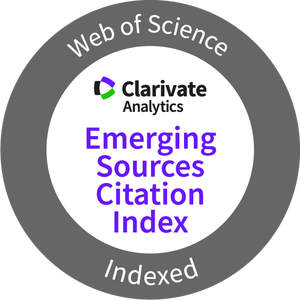Validity and test-retest reliability of a kinesthetic perception test for blind people
Abstract
Blind people need kinesthetic perception as feedback for providing information related to movement characteristics, such as position in space and direction. The research purpose was to determine the validity and test-retest reliability of of a kinesthetic perception test for blind people. The test consists of placing both the feet correctly on 4 square targets (5 cm thick) placed on the right, left, front, and back, at a distance of 100 cm from the initial position that is located in the middle, following the audio stimulus with a time limit of 10 seconds per repetition. The researchers used 3 experts to evaluate the validity of the test. The test-retest reliability was evaluated in a total of 50 people who were totally blind. Aiken V coefficient was used to test the validity and Cronbach’s alpha correlation test was used to test the test retest reliability. The research results showed a value of Aiken V of 0.86 > 0.77, and a reliability of 0.816 > 0.60. Therefore, it can be concluded that the kinesthetic perception test for blind people presented in this manuscript is valid and reliable.
Downloads
References
Abdul Karim, K. A. (2020). The challenges faced by visual impairments in buying clothes and how to wear clothes. Idealogy Journal, 5(2), 73–78.
Alcaraz Martínez, R., Turró, M. R., & Granollers Saltiveri, T. (2022). Methodology for heuristic evaluation of the accessibility of statistical charts for people with low vision and color vision deficiency. Universal Access in the Information Society, 21(4), 863–894.
Ali, H. S., & Saleh, S. (2021). The Accuracy of Serving Direct from the Top and its Relationship with the Sensorimotor Perception of Young People for the Volleyball Al-Sinaa Sport Club Team. Annals of the Romanian Society for Cell Biology, 25(6), 11137–11143.
Atteng, C. J. (2021). Social inclusion as a task in the developmental process of persons with visual impairment : implication for special needs counselling. European Journal of Public Health Studies, 4(1), 22–36. https://doi.org/10.46827/ejphs.v4i1.86
Castro, K. J. S., Salomão, R. C., Feitosa Jr, N. Q., Henriques, L. D., Kleiner, A. F. R., Belgamo, A., … Souza, G. S. (2021). Changes in plantar load distribution in legally blind subjects. PloS One, 16(4), e0249467.
Gall, M. D. (2010). Applying Educational Research: How To Read, Do, and Use Research to Solve Problems of Practice. Pearson.
Łącka, I., & Brzezicki, Ł. (2021). Efficiency of the research and development activities of technical universities in Poland. Social Inequalities and Economic Growth, 63(3), 258–274.
Latash, M. L. (2021). Production and perception of intentional and unintentional actions. Journal of Human Kinetics, 76(1), 51–66.
Likova, L. T., Mei, M., Mineff, K. N., & Nicholas, S. C. (2019). Learning face perception without vision: Rebound learning effect and hemispheric differences in congenital vs late-onset blindness. Electronic Imaging, 2019(12), 231–237.
Marelli, S., Castelnuovo, A., Somma, A., Castronovo, V., Mombelli, S., Bottoni, D., … Ferini-Strambi, L. (2021). Impact of COVID-19 lockdown on sleep quality in university students and administration staff. Journal of Neurology, 268(1), 8–15.
Meléndez-Jara, C. M., Ramírez-Sáenz, N. L., & Tafur-Mendoza, A. A. (2021). Parental Competencies in Mothers of Infants with Disabilities and their Relationship to Adaptive Behavior and Motor Development. International Journal of Early Childhood Special Education, 13(1), 121-131.
Misko, A. L., Weinstock, L. D., Sankar, S. B., Furness, A., Grishchuk, Y., & Wood, L. B. (2022). Peripheral Inflammatory Cytokine Signature Mirrors Motor Deficits in Mucolipidosis IV. Cells, 11(3), 546.
Noble, S., Scheinost, D., & Constable, R. T. (2021). A guide to the measurement and interpretation of fMRI test-retest reliability. Current Opinion in Behavioral Sciences, 40, 27–32.
Real, S., & Araujo, A. (2020). VES: A mixed-reality system to assist multisensory spatial perception and cognition for blind and visually impaired people. Applied Sciences, 10(2), 523.
Sigrist, R., Rauter, G., Riener, R., & Wolf, P. (2013). Augmented visual, auditory, haptic, and multimodal feedback in motor learning: a review. Psychonomic Bulletin & Review, 20(1), 21–53.
Stopar, K. (2020). Device for visual kinesthetic navigation of the blind and visually impaired. 2020 IEEE 20th Mediterranean Electrotechnical Conference (MELECON), 646–651.
Tanaka, A., & Parkinson, A. (2016). Haptic wave: A cross-modal interface for visually impaired audio producers. Proceedings of the 2016 CHI Conference on Human Factors in Computing Systems, 2150–2161.
Tsang, S., Royse, C. F., & Terkawi, A. S. (2017). Guidelines for developing, translating, and validating a questionnaire in perioperative and pain medicine. Saudi Journal of Anaesthesia, 11(5), 80.
Van der Ham, A. J., Van der Aa, H. P. A., Brunes, A., Heir, T., de Vries, R., Van Rens, G. H. M. B., & Van Nispen, R. M. A. (2021). The development of posttraumatic stress disorder in individuals with visual impairment: A systematic search and review. Ophthalmic and Physiological Optics, 41(2), 331–341.
Žukauskas, P., Vveinhardt, J., & Andriukaitienė, R. (2018). Structure of Research Design: Expert Evaluation. In Management Culture and Corporate Social Responsibility. IntechOpen.
The works and papers that are published in this Journal are subject to the following terms:
1. The Publication Service of the University of Murcia (the publisher) has the Publication Rights (Copyright) to the published papers and works, and favors and permits the reusing of the same under the license indicated in point 2.
© Servicio de Publicaciones, Universidad de Murcia, 2013
2. The papers and works are to be published in the digital edition of the Journal under the license Creative Commons Reconocimiento-No Comercial-Sin Obra Derivada 3.0 España (legal text). The copying, using, spreading, transmitting and publicly displaying of the papers, works or publication are permitted as long as: i) the authors and original sources (Journal, publisher and URL of the publication) are quoted; ii) it is not used for commercial benefit; iii) the existence and specifications of this users license are mentioned.
3. Conditions of Self-Archiving. It is permitted and encouraged that the authors spread electronically the pre-print (before printing) and/or post-print (the revised, evaluated and accepted) versions of their papers or works before their publication since this favors their circulation and early diffusion and therefore can help increase their citation and quotation, and also there reach through the academic community.
The works and papers that are published in this Journal are subject to the following terms:
1. The Publication Service of the University of Murcia (the publisher) has the Publication Rights (Copyright) to the published papers and works, and favors and permits the reusing of the same under the license indicated in point 2.
© Servicio de Publicaciones, Universidad de Murcia, 2013
2. The papers and works are to be published in the digital edition of the Journal under the license Creative Commons Reconocimiento-No Comercial-Sin Obra Derivada 3.0 España (legal text). The copying, using, spreading, transmitting and publicly displaying of the papers, works or publication are permitted as long as: i) the authors and original sources (Journal, publisher and URL of the publication) are quoted; ii) it is not used for commercial benefit; iii) the existence and specifications of this users license are mentioned.
3. Conditions of Self-Archiving. It is permitted and encouraged that the authors spread electronically the pre-print (before printing) and/or post-print (the revised, evaluated and accepted) versions of their papers or works before their publication since this favors their circulation and early diffusion and therefore can help increase their citation and quotation, and also there reach through the academic community.


















